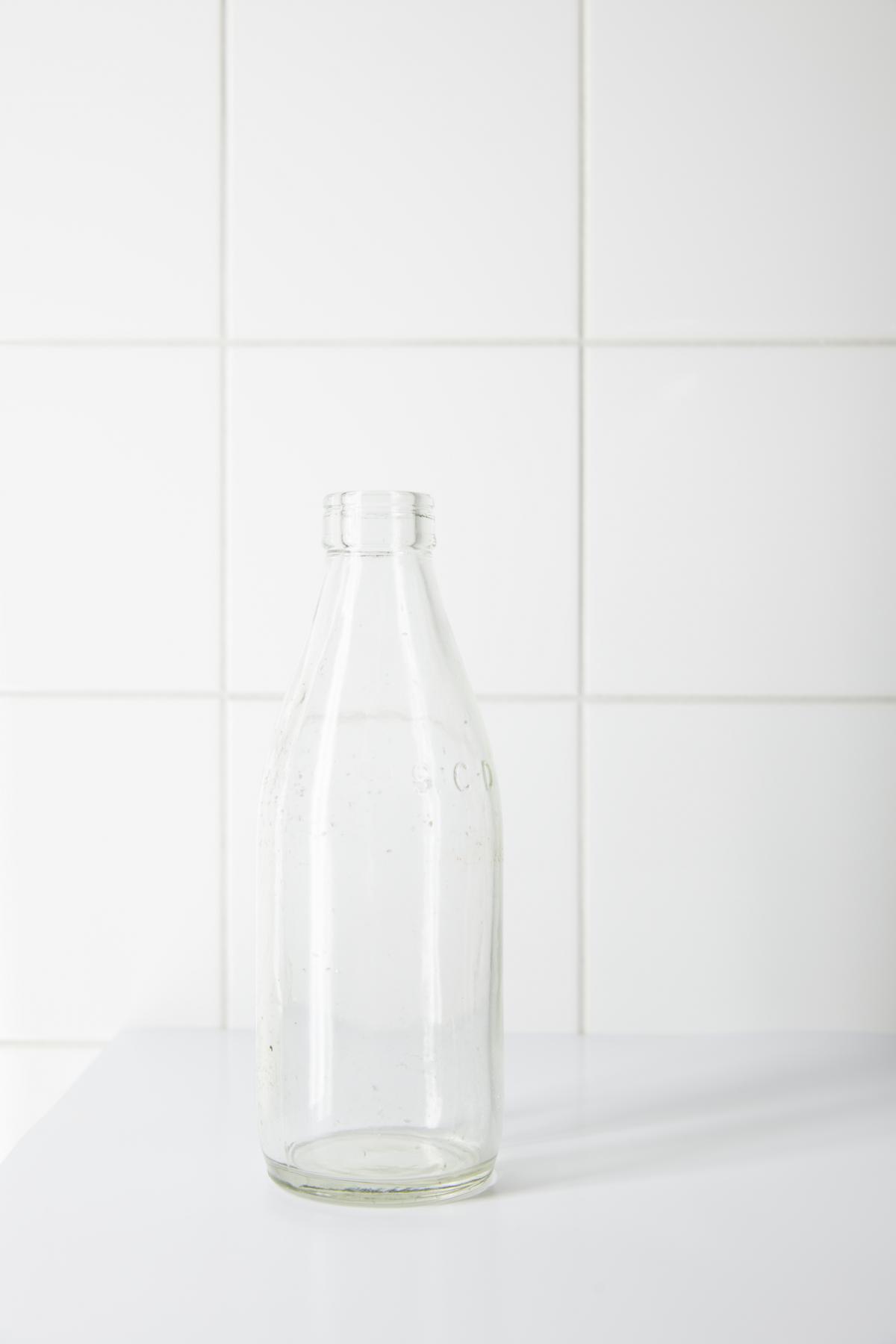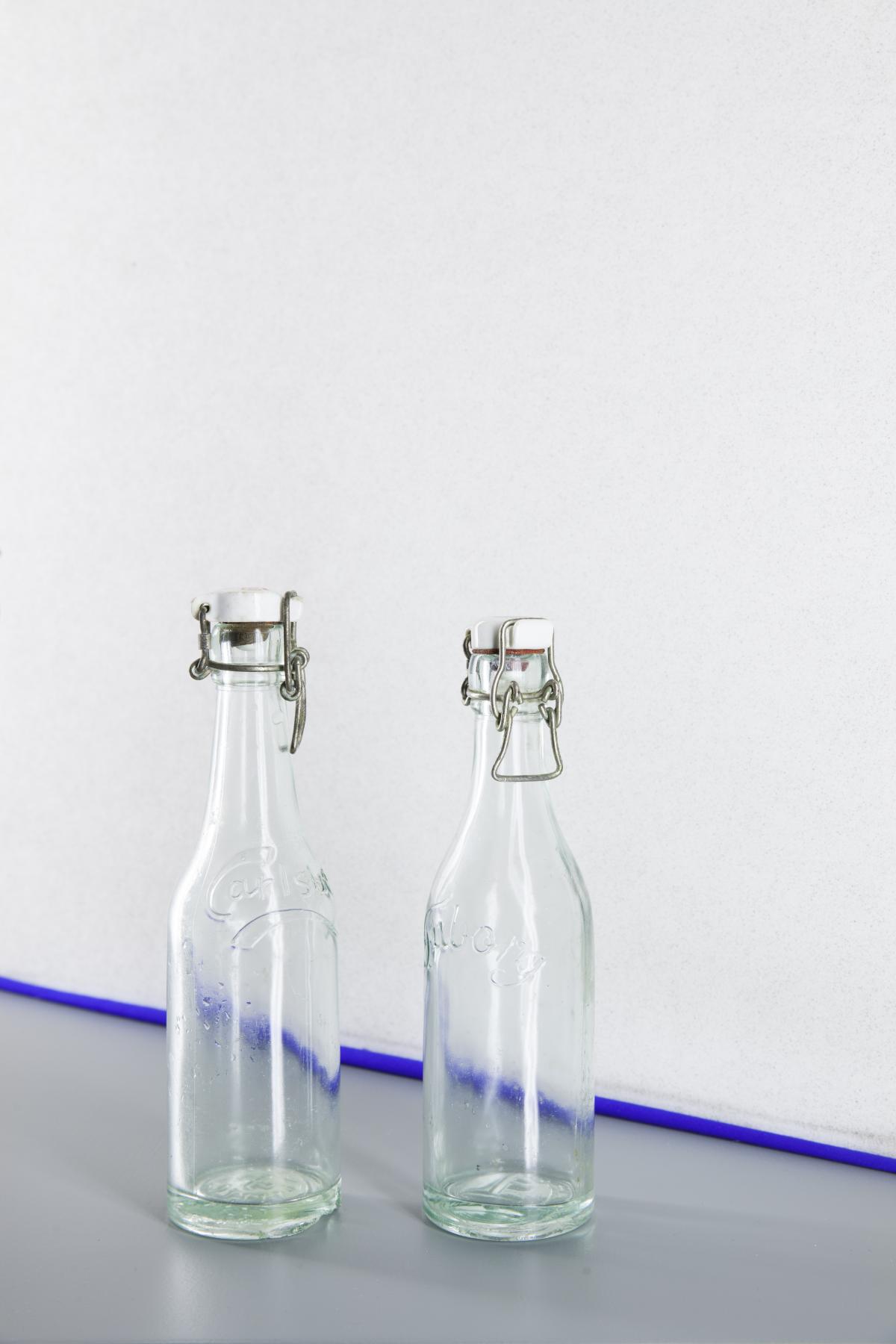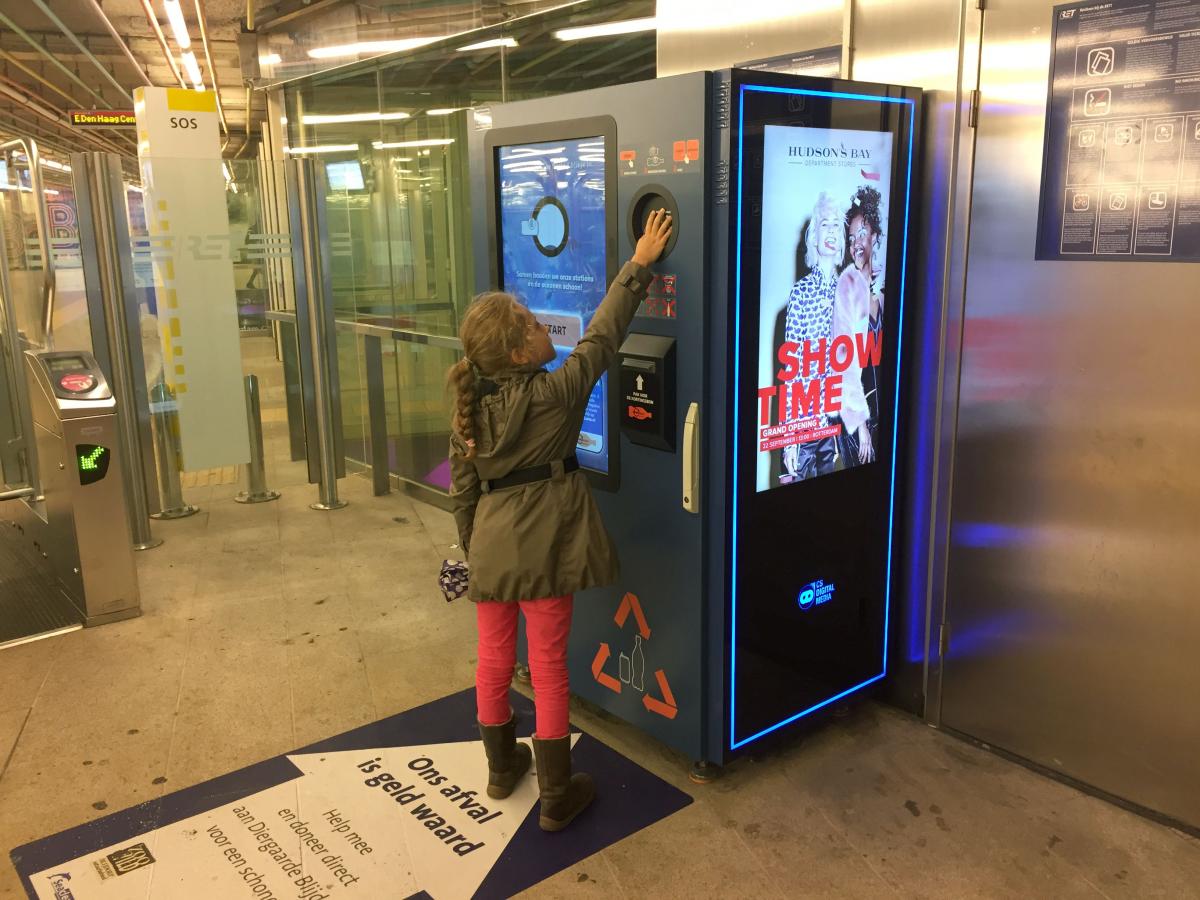Return To Maker
Concerns over the environmental effect of plastic waste are mounting nearly as quickly as the tons of plastic bottles discarded every year. Bottle-deposit schemes are proof that a little financial incentive can encourage people to return beverage containers for recycling.
Cover Photo: On average, a German mineral water bottle is filled and used 50 times before being pulled from circulation for recycling. Two barely perceptible glass bulges, which protect the paper label, wear down and indicate the age: from left to right, the bottles in the photo range from a freshly recast one to a battered one that is ready to be pulled from circulation and melted down yet again. (Photo: Nadine Stijns)
Printed on the back of most beverage containers is a fragment of the circular economy.
The bottle deposit return scheme gives customers money back for bringing empty beverage containers back to stores. Its traces can be seen in the fine print on beverage cans and store receipts, where a bottle ‘rental’ fee is applied. Its roots go back 100 years, and though it virtually disappeared with the arrival of ‘throwaway culture’, it is making a comeback in the face of the deluge of plastic bottles clogging streets, landfills and waterways.
‘A few states in Australia have just announced that new programmes will start soon, […] Scotland just announced that they will have a new container deposit law, and then just last week, Malta did the same. Several months ago, Lithuania made a similar announcement,’ explains Susan Collins, director of the California-based not-for-profit Container Recycling Institute (CRI). ‘2017 has been a very big year for container deposit programmes worldwide,’ she reports.
You seem to enjoy a good story
Sign up to our infrequent mailing to get more stories directly to your mailbox.A & R Thwaites & Co, an Irish soda water producer, is credited with the invention of the bottle deposit scheme. In 1799, to encourage customers to return their heavy-duty glass bottles, the Dublin-based company offered two shillings for every dozen returned. Manufacturing glass containers was very costly then, with most bottles still produced by hand-blowing until the 1900s. In Norway, where returning bottles or ‘panting’ is still very much part of everyday life, competing beverage companies agreed on two standard sizes for the bottles they shared. In the 1960s and 1970s, ‘35-centilitre (12 oz) bottles were reused 23 times and 70-centilitre (24 oz) bottles 18 times, on average,’ as historian Finn Arne Jørgensen writes in Making a Green Machine: The Infrastructure of Beverage Container Recycling.
Coca-Cola started bottling their syrupy beverage in 1899, enchanting housewives with the luxury of serving colas at home. Until then, Coke was consumed by the glass, on the spot in pharmacies and restaurants. In 1916, Coca-Cola introduced the iconic contour bottle, a curvy, green-coloured model that was sold, collected, washed and refilled. Many vintage Coke bottles were even inscribed with a reminder: ‘Money back bottle. Return for deposit’. Bottles then were considered ‘borrowed’ and were technically owned by the beverage company, not the consumer.
But with millions of glass bottles in circulation by the 1940s, shopkeepers began complaining about the inconvenience of storing used containers, and beverage companies were saddled with the expensive and laborious process of sanitising them, as Jørgensen describes:
‘Cleaning bottles was a labour-intensive job. The bottles had to be thoroughly washed in the bottling plant before they could be refilled. In 1899, the women—because this was a woman’s job—who washed, filled, and capped bottles were paid thirty øre per one hundred bottles. […] Some bottles needed extra cleaning, since it was common to store kerosene in them; stores sold kerosene wholesale and empty bottles were a convenient way for customers to bring it home. Some of the women had as their job to smell all the incoming bottles, and if they caught so much as a little whiff of kerosene, the bottle had to be sent to special cleaning. Machines later took over much of the cleaning work, but the inspection process still required people to ensure that the bottles were clean.’
After the Second World War, everything changed. Propelled by advances in glass manufacturing, American beverage companies started selling lighter, more portable throwaway bottles. Soda bottles then were inscribed with the words ‘No Deposit, No Return’. The August 1955 issue of Life magazine, called ‘Throwaway Living’, celebrated disposable items, underscoring the freedom from having to clean and repurpose household items.

The first glass milk bottle was patented in 1874 in the USA, but the invention crossed the Atlantic to become an archetypical part of British lives. In the 1960 and 1970s, over 90% of milk in the UK was put into glass bottles to be delivered by milkmen directly to families’ doors. The empty bottles were picked up daily at a time when the concept of recycling was hardly discussed. The proliferation of refrigerators and the advent of chain supermarkets changed everything, and environmentally friendly glass bottles were replaced by throwaway plastic containers or cartons, which are cheaper to manufacture and lighter to transport. (Photo: Nadine Stijns)
To demonstrate how grave plastic bottle pollution has become, the Plastic Ocean Foundation and the UK entertainment channel Lad Bible petitioned the UN to declare a patch of floating plastic debris in the Pacific Ocean as a country. ‘Trash Isles’, as it’s called, has an area the size of France. Former US vice president Al Gore has agreed to be its first honorary citizen.
Americans became so enamoured of the idea of convenient, single-use containers that a littering problem emerged in the 1950s. Discarded bottles and aluminium cans cluttered streets, parks, highways and forests, making once-pristine areas look like rubbish tips. In 1953, beverage and packaging manufacturers such as Coca-Cola, the American Can Company and Owens-Illinois Glass Company, who invented ‘one-way’ disposable bottles, established the ‘Keep America Beautiful’ campaign. Its intent was to emphasise that careless individuals, not the mountains of throwaway containers, were responsible for the epidemic of litter. Their massive, well-funded media campaign and lobbying ensured that disposable bottles continued to be unregulated.

Mass-scale bottle return has existed in Denmark since 1922, when breweries entered into a voluntary agreement to use a common bottle for beer and soft drinks instead of unique branded bottles. The Danish bottle return system was widely called the world’s best, with a return rate of nearly 100%. Until 2002, the sale of beer and soft drinks in cans was not allowed in Denmark, but this was challenged by the EU Commission, bringing disposable beverage packaging to Denmark, and introducing a bottle deposit system. In this photo, a 33 cl (11 oz) soft drink bottle manufactured in Carlsberg in the 1930s. (Photo: Nadine Stijns)
Despite evidence that paying people money for empty containers significantly helps reduce waste, only ten US states—California, Connecticut, Hawaii, Iowa, Maine, Massachusetts, Michigan, New York, Oregon and Vermont—plus the territory of Guam have container deposit legislation in place today. Michigan, which gives the highest rewards for returned bottles, has a bottle recycling rate of 95%, compared to the 30% national average.
The UK has a similar problem with litter. British lawmakers have recently been touting the old money-back scheme as a potential solution to arrest the proliferation of tossed bottles—currently an average of four million bottles a week throughout the UK. ‘A deposit scheme will generate higher quantities of material of higher quality for recycling, with attendant benefits for the global climate,’ said Dominic Hogg, chairman of the environmental consultants Eunomia Environmental, who produced an environmental audit report for the Parliament in June.
Zero-waste advocates are now studying successful deposit return schemes in Scandinavia as a possible way to reduce the mountains of plastic accumulating every year.
Among the technologies they’re studying is the reverse vending machine (RVM), which is standard equipment in most supermarkets in Norway, Finland and Sweden. The majority of these bottle-collecting machines are supplied by a Norwegian company called TOMRA. Equipped with automatic container recognition systems, TOMRA’s machines can rapidly scan and sort collected bottles, calculate the total deposits to be returned, and print a receipt redeemable at the cash register. In places where these high-capacity machines are present, more than 70% of containers of all beverages sold are returned for recycling. TOMRA reports that their machines capture about 35 billion containers every year, avoiding greenhouse gas emissions equivalent to two million cars driving 10,000 km (6,214 mi).

A reverse vending machine at Rotterdam’s central train station that accepts empty glass and plastic bottles as well as aluminium cans. The machine dispenses ecoeuros, green coupons that can be redeemed for goods and services in local stores or donated to a linked charity or social partner, encouraging residents to help keep the city clean. (Photo: Peter Biľak)
Not everyone supports the return of bottle recycling, however. CRI outlines how beverage companies propagate myths to combat bottle deposit campaigns because producing new containers is much easier than grappling with the logistics of recycling. ‘The arguments bottle recycling proponents encounter most frequently include the following: deposits duplicate kerbside recycling, are a public health threat, are inefficient, are outdated, are a regressive “tax”, and will damage local businesses and lead to closures or layoffs,’ it says. ‘Most of their arguments are simply not well-grounded in truth.’
Norwegians also warn, however, that legislation or technology alone isn’t enough to get the world to go back to returning used bottles. In most countries, there is a stigma associated with returning bottles for money, and the task is often relegated to ‘canners’, poor and underemployed people who rummage through rubbish bins to make cash from discarded bottles and cans. For the public to embrace the bottle deposit scheme will require a cultural shift. According to Simen Knudsen of Nordic Ocean Watch, ‘People [in Norway] understand they are borrowing the bottle but buying the content.’

